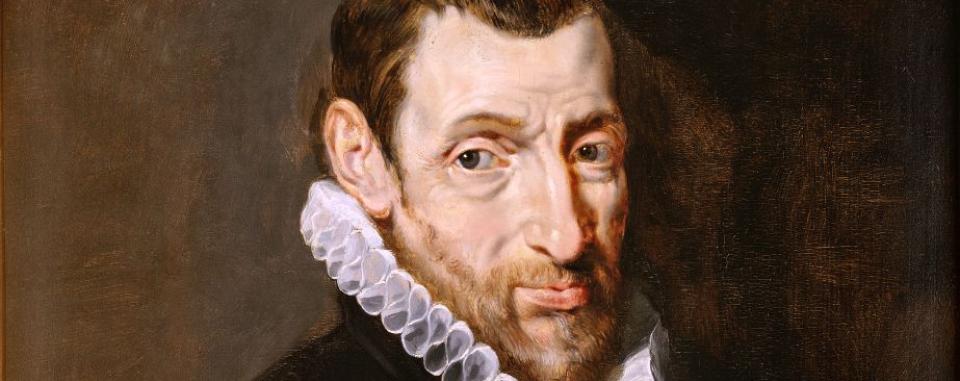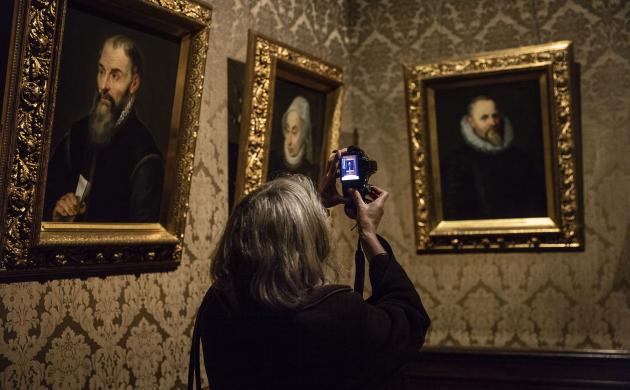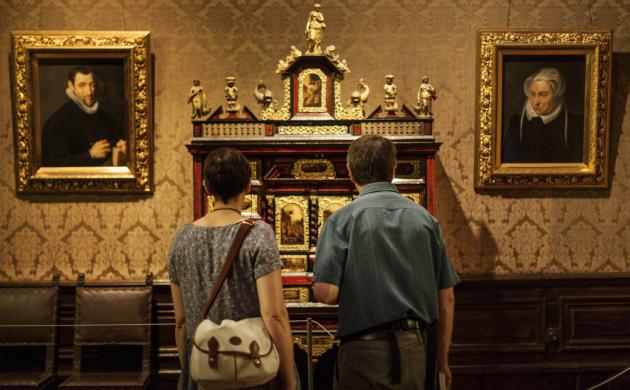Plantin: life
Christophe Plantin (1520-1589): founder and head of the Officina Plantiniana from 1555 to 1589.
Youth and marriage
Plantin was born in Saint-Avertin, a hamlet in the region of Tours in France, in about 1520. He learnt bookbinding and printing from Robert II Macé in Caen, Normandy. There, he met Jeanne Rivière. He married her in around 1545, and the couple had five daughters:
- Margaretha (1547-1594)
- Martine (1550-1616)
- Catharina (1553-1622)
- Magdalena (1557-1599)
- Henrica (1561/1562-1640)
Their only son, Christoffel, born in 1566, died in infancy before 1570.
Plantin in Antwerp
Shortly before 1550, Plantin settled in Antwerp. He initially earned his living as a bookbinder and leatherworker. He became a burgher of the city in 1550 and planned to become a printer.
Plantin establishes a business as a printer
In 1555, Plantin set up as a printer. He may have initially obtained financial support from the heterodox sect known as the ‘Huis der Liefde’ (‘House of Love’), and later – from 1563 onwards – from Calvinist partners. With this support he developed his business into the largest typographical undertaking of the second half of the 16th century.
Plantin suspected of heresy
The second half of the 16th century was no easy time for writers and their printer-publishers. Religious intolerance was rife. The Southern Netherlands were under Spanish control, so Roman Catholicism was imposed. In 1562, Plantin got into trouble when a Calvinist pamphlet was discovered during a raid on his print shop. The bad news reached Plantin while he was on a business trip. To escape persecution, he remained in Paris for a year and a half until his name was cleared. In September 1563, he returned to Antwerp, where all his furniture had in the meantime been sold to the public. But presumably the creditors/wholesale buyers were friends of Plantin, who managed to ensure that the government did not impound his property. They subsequently became his partners.
Success
Back in Antwerp, Plantin received the support of some wealthy local financiers, who saw the energetic entrepreneur as a sound investment. The Officina Plantiniana, which had already moved several times due to lack of space, became a ‘compagnie’. Over a period of five years, the presses, which Plantin purchased second-hand, printed some 260 publications.
Back in danger
This collaboration came to an end in 1567. Plantin’s partners, who were convinced Calvinists, fled the Netherlands just before the arrival of the Duke of Alba. But the real danger to Plantin lay in Vianen, near Utrecht. In this Calvinist stronghold, Plantin secretly helped to establish an anti-Spanish printing works. This act of high treason could have cost him his head.
The polyglot Bible: a gigantic project
To clear himself of all suspicion, Plantin sang the praises of the Catholic Church in letters to powerful protectors in this period. He developed a plan that he suspected would be of interest to the ultra-Catholic King Philip II: a scholarly edition of the Biblical texts that would be the largest polyglot (multilingual) Bible of the 16th century.
The plan worked: in September 1567, Plantin learned that Philip II was willing to provide financial support. In March 1568, the king sent the great Spanish theologian and humanist Benedictus Arias Montanus to Antwerp to oversee the publication. Five years later, in 1573, the giant project was completed: an edition of the Bible in five languages and eight monumental volumes... a truly ‘royal’ Bible or Biblia regia.
Arch-printer to the king of Spain
The largest printing business of the age brought its printer an honorary title in 1570, while work was still in progress on the Biblia regia: Arch-Printer to the King. Aristocratic associates also secured lucrative contracts for him in 1571 for the printing of missals, breviaries and other religious mass products for the Spanish market and its colonies.
Political unrest in Antwerp
In early November 1576, when Plantin had just established the business at its premises on Vrijdagmarkt, the so-called Spanish Fury was unleashed on Antwerp. The burning down of the new town hall, the murder of hundreds of civilians and the operation of a large-scale protection racket by the mutinous Spanish troops drove the city to support insurrection.
Trade with Spain, Plantin’s main market, took a severe dent. Plantin was caught between the different parties: to the outside world, he remained a Catholic, yet he also printed anti-Spanish pamphlets and works. In 1578 he even became the official printer of the States General, the institution that led the uprising, and in 1579 he worked for the Antwerp’s Calvinist city council.
Plantin becomes printer to the University of Leiden
When the Spanish governor-general Alexander Farnese began the siege of Antwerp after the fall of Lier in 1582, Plantin decided to get out. In case the city was captured and his Antwerp printing operation collapsed, he founded a reserve business in Leiden in 1582. He settled there in 1583. Plantin was by then about 63 years old.
In Leiden, the newly founded university had created new sales opportunities. On the recommendation of the great humanist Justus Lipsius, Plantin was appointed as university printer. He established the first scientific publishing house and bookshop in the Northern Netherlands there. His sons-in-law now ran the business in Antwerp.
Plantin returns to Antwerp
Plantin did not thrive in Leiden. By the time Antwerp finally fell to the Spanish in August 1585, he was already on his way back. In 1586, his son-in-law Franciscus Raphelengius, a convinced Calvinist, took over the Leiden branch of the business. Economic recovery failed to occur in the Southern Netherlands until the 1590s. At the end of his life, Plantin therefore experienced the decline of Antwerp and his printing business, much to his disappointment.
Death
On 1 July 1589, after thirty-four years of activity as a printer, Christophe Plantin died.
He is buried in the Cathedral of Our Lady.
Plantin as printer-publisher
The Officina Plantiniana was the largest typographical business in 16th-century Europe. Plantin was a shrewd businessman, as his ideological pragmatism underlines. Plantin was a trimmer in times of political chaos and religious turmoil, publishing works by both Protestants and Catholics. He also ran a thriving book trade, selling works from other publishers and prints as well as his own publications.
Peak productivity
The Antwerp printer’s most productive period was in the years before the Spanish Fury of 1576. Between 1568 and 1572/73, Plantin printed his masterpiece, the Biblia Polyglotta. At that time, Plantin had sixteen presses, thirty-two printers, twenty compositors, three proof-readers and various servants. By way of comparison, the famous 16th-century printing business of the Estienne family in France had just four presses in operation.
A new book every week
In his 34-year career as a printer and publisher, Plantin issued some 2,450 titles. When minor works are deducted from this total, this still leaves 1,887 publications – an average of 55 per year. This would be an impressive figure even today.
Every week, he completed a new book, with a print run of between 1,000 and 1,250 copies. This is also the average number of sheets that two printers can process per day on a single press. In the case of successful books, the print run was sometimes as high as 2,500. Plantin achieved his largest circulation with his Hebrew Bible of 1566, which was printed in 7,800 copies.
Intellectual public
Plantin's works were mainly intended for an intellectual and international public of scholars, students, clergy, military officers and others. His books were sold in the Netherlands, the Holy Roman Empire, France, Spain and its colonies in America, Italy, England and the North African regions.
Plantin and humanism
Since the early 16th century, Antwerp had been an important centre of humanism. His correspondence shows that Christophe Plantin was in close contact with all the leading humanists in the Netherlands and beyond. Some of them were close friends.
Christophe Plantin had great affection for Justus Lipsius (1547-1606), the most important humanist of the Southern Netherlands in the 16th century after Erasmus. Through him, the circle of humanists around Plantin expanded considerably. Justus Lipsius had almost his entire oeuvre printed by Plantin, who even kept a room specially for him to live and work in – now known as the ‘Justus Lipsius Room’. Here, the humanist could directly correct the proofs of his work.
Plantin was no scholar himself: he was self-taught. He was intellectually very gifted and cultivated his knowledge of languages, but above all he was a businessman with scientific interests.
An overview of Plantin's publications
Plantin printed religious works, but was also the leading printer of humanism and the sciences in the second half of the 16th century.
His humanistic publications include dictionaries and works on grammar, the humanities, fable books and editions of emblemata.
The scientific works include publications on cartography, mathematics (8), astronomy, astrology (33), physics (28), botany (22) and medicine (55).
Religious works
Plantin produced numerous Biblical texts and prayer books. With the rise of Protestantism in the Reformation and the Catholic reaction to this in the Counter-Reformation, there was much interest in such works. In 1571, the printer to King Philip II received large orders for the production and sale of liturgical works in Spain and the Spanish colonies overseas. He printed thousands of breviaries, missals and books of hours.
Scientific works
Plantin had an eye for business and knew exactly which books would sell well. Thanks in part to his excellent contacts with the leading scholars of his time, large numbers of scientific manuscripts came in to the Officina Plantiniana to be printed.
Botany: the tulip
Plantin was the most important publisher of the leading botanists of his day, such as Rembert Dodoens, Mathias Lobelius and Carolus Clusius. Clusius was one of the first from this part of the world to study the tulip, which he may have obtained through Ogier Ghislain de Busbecque, the Holy Roman Emperor’s ambassador to the Turkish sultan. The tulip came here from the Ottoman Empire – like the lilac and the horse chestnut.
Cartography
In the second half of the 16th century, Antwerp was a leading international centre of geography and cartography. From 1558, Christophe Plantin maintained close professional and personal contacts with Abraham Ortelius. In 1579, he printed the first modern atlas for the geographer: the Theatrum orbis terrarum or ‘Theatre of the world’.
Anatomy
Plantin published Juan de Valverde’s Vivae imagines partium corporis humani, an imitation of the work by the famous Andreas Vesalius. He also printed practical medical works for surgeons.
Mathematics
Plantin printed groundbreaking mathematical works by scholars such as Simon Stevin.
Lexicography
Plantin rendered particularly invaluable services to Dutch lexicography or dictionary-making, including the Thesaurus Theutonicae linguae and the Dictionarium Teutonico Latinum. To improve his Dutch, he took the initiative of compiling the first scientific Dutch dictionary. His proof-reader Cornelis Kiliaan produced this work.
Music
Music printing in the Netherlands flourished in the second half of the 16th century. Music printers such as Susato, Phalesius and Plantin were world-famous. Masters of typography Hendrik Van den Keere and Robert Granjon supplied Plantin with original matrices and punches.



